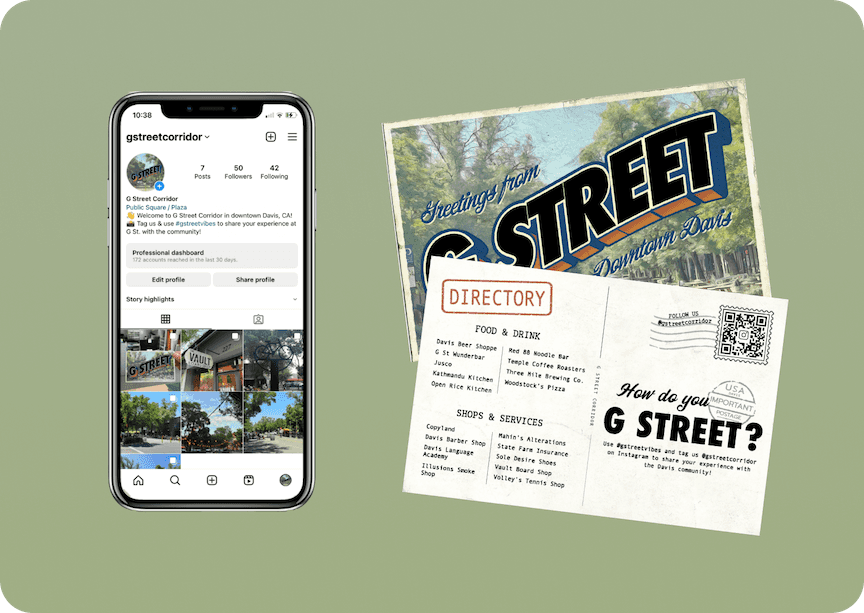Skills:
user research, prototyping, user testing, and visual graphic design
Client:
City of Davis
Team:
Janice | Jasmine | Jennifer | Jonathan
Timeline:
April 2023-June 2023
The G Street corridor, located in the heart of downtown Davis, is a thriving center of commerce and dining. In response to the COVID-19 pandemic, the street has been closed to cars through the use of blockades. The primary aim of this project is to increase the visibility and accessibility of the G Street corridor, thereby enabling a broader audience to discover and patronize its many businesses.
The Problem: An Unseen Gem & Fragmented Identity
How Might We: Enhance the discoverability of the G Street Corridor to foster a stronger sense of community and draw more visitors to its businesses?

Why Human Centered Design
Puts people at the core of the design process
Analyzes users' experiences to uncover unmet needs and desires
Creates a targeted solution
My Role & Approach
As part of a four-person UX design team, I contributed to the end-to-end human-centered design process. Our approach was rooted in putting people at the core of our design, analyzing user experiences to uncover unmet needs, and creating targeted solutions that directly addressed G Street's discoverability challenge.
User Interviews
As a team, we conducted 11 30-60 minutes interviews with UC Davis students, other Davis residents, and non-residents. Notably, some people had no idea what G St. was, and another person said, "It's just a street... isn't it?" (reword this)

We created an empathy map to analyze and compartmentalize our users' actions, thoughts, and feelings.
Some of our users visited places like Woodstock's or Temple, but they really had no idea they were at G St.
Found out that the users couldn't recognize G St. Corridor as its own entity because businesses there lacked cohesion even though they were a part of something together.
That is when we decided to foster a sense of community to engage both businesses and potential G St. visitors.

Part 1: Postcards (with directory)
We included a QR code on the postcard that links to our Instagram account.

Why a postcard?

Part 2: Instagram Account

We came up with different G-street hashtags like (#gstreetvibes, #gstreetcorridor, #discovergstreet), and used them in our posts.
Why Instagram?

Testing-Postcard

Engaging with business owners about our idea and asking them to display our postcards in their businesses
Also asked people at G Street simple questions about the overall design and effectiveness
Testing-Instagram


Feedback Posts
Direct Messages from Business Owners

Instagram Insight Data

A steady increase in the number of non-followers who viewed our account transitioned into followers ever since we passed out the postcards
Reflects that the postcards effectively advertised our Instagram account and Instagram encouraged interactions and engagement among the Instagram users
Learnings & Future Considerations
This project was a fantastic journey, teaching us some key lessons that will shape our future work:
The Power of Tangible Meets Digital: We truly saw how effective it is to combine something physical, like our postcards, with a vibrant digital space like Instagram. It's a powerful way to reach different people and really make a community initiative stick.
Crafting an Identity for Places: It became clear that giving a physical location, like G Street, its own unique story and brand is crucial. It helps people see it as more than just a street—it becomes a place they want to visit and connect with.
Learning on the Go: Getting feedback directly from people on G Street and watching how our Instagram posts performed in real-time was incredibly valuable. It showed us how quickly we could learn and adjust our approach to make a real difference.
Looking Ahead: We really hope the City of Davis takes this foundation and continues to build G Street's reputation as a must-visit spot in Davis, making it an even bigger draw for everyone.


